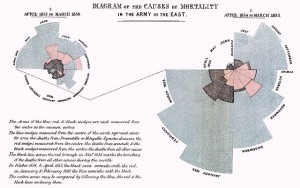This year we’re holding the first of our Analytics Series conferences in London, right by Waterloo Station. Not too far from the hotel is the Florence Nightingale Museum. Most of us (at least in Britain) know her well from school as ‘the Lady with the Lamp’. Florence Nightingale is most famous as the founder of the modern profession of nursing and a champion of women’s rights in a very different time to our own. But fewer probably know that she was also a pioneering statistician.
Florence Nightingale was born into a wealthy British family in the Italian town of Florence; hence her name. Her career was spent in the service of others and she helped look after wounded soldiers during the battle of the Crimea during the 1850s. There she acquired her moniker ‘The Lady with the Lamp’ as she would do her rounds in the military hospital with a small lamp.
Florence Nightingale was also an accomplished statistician. Although she had not formal training in the subject, as a girl she had shown an aptitude for mathematics and took to the use of numbers to back up her arguments for improved sanitation as key to public health. In fact, she showed a particular interest in data visualization. She made good use of the existing bar chart and pie chart, but went on to develop her own variation on the bar chart known variously as the ‘Nightingale rose diagram’, circular histogram, polar area diagram or “coxcomb”. You can see her chart below.
It’s essentially a stacked bar chart arranged around a central point, with each segment representing a month. It is especially useful for showing cyclical classifications; hours, days, months, points of the compass etc. But not so useful for classification variables such as year, gender or country.
You can create a polar area diagram in JMP and similar diagrams are available in SAS including the Windrose diagram in PROC GRADAR.
So, when you’ve got a moment during your visit to London for the Analytics Series Conference, perhaps take a break and visit Florence Nightingale’s museum, see her statue, you can also often see a stained glass window of her in many London churches.
References:
Wikipedia: http://en.wikipedia.org/wiki/Florence_Nightingale
Celebrating statisticians: Florence Nightingale, Laura Lancaster: https://blogs.sas.com/content/jmp/2013/02/04/celebrating-statisticians-florence-nightingale/

